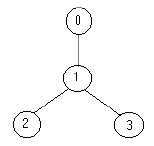POJ - 1463-Strategic game(最小点覆盖)
Bob enjoys playing computer games, especially strategic games, but sometimes he cannot find the solution fast enough and then he is very sad. Now he has the following problem. He must defend a medieval city, the roads of which form a tree. He has to put the minimum number of soldiers on the nodes so that they can observe all the edges. Can you help him?
Your program should find the minimum number of soldiers that Bob has to put for a given tree.
For example for the tree:

the solution is one soldier ( at the node 1).
Input
The input contains several data sets in text format. Each data set represents a tree with the following description:
the number of nodes
the description of each node in the following format
node_identifier:(number_of_roads) node_identifier1 node_identifier2 … node_identifiernumber_of_roads
or
node_identifier:(0)
The node identifiers are integer numbers between 0 and n-1, for n nodes (0 < n <= 1500);the number_of_roads in each line of input will no more than 10. Every edge appears only once in the input data.
Output
The output should be printed on the standard output. For each given input data set, print one integer number in a single line that gives the result (the minimum number of soldiers). An example is given in the following:
Sample Input
4
0:(1) 1
1:(2) 2 3
2:(0)
3:(0)
5
3:(3) 1 4 2
1:(1) 0
2:(0)
0:(0)
4:(0)
Sample Output
1
2
- 题目大意:
给你一个图(实际上是一个树),让你找最少的点,然后能把所有的边都覆盖掉,啥叫覆盖呢?就比如题目中的那个图吧,就是1 这个点 覆盖三条边,0那个点覆盖一条边。就是这个点所连的边就是它所覆盖的边。
这是一类问题,归为求最小点覆盖问题。 - 解题思路:
最小点覆盖数就是最大匹配数
证明嘛 看一下大佬的博客吧大佬博客因为我是个菜鸡,所以我个人认为,掌握这个证明并不是必须的,只要你能记住这个定理就好啦。至于怎么求最大匹配,就是用匈牙利算法求了。 - AC代码:
#include <iostream>
#include <cstring>
#include <cstdio>
using namespace std;
const int maxn=1501;
struct node
{
int to;
int next;
}side[maxn*2];
int used[maxn];
int head[maxn];
int ans[maxn];//用来存答案
int vis[maxn];//用来分二分图的
int cnt=0;
int n;
void init()
{
memset(head,-1,sizeof(head));
memset(ans,0,sizeof(ans));
memset(used,0,sizeof(0));
cnt=0;
}
void add(int x,int y)
{
side[cnt].to=y;
side[cnt].next=head[x];
head[x]=cnt++;
}
bool dfs(int x)
{
for(int i=head[x];i!=-1;i=side[i].next)
{
int y=side[i].to;///与x相连接的点
if(used[y]==0)
{
used[y]=1;
if(ans[y]==0||dfs(ans[y]))
{
ans[y]=x;
return true;
}
}
}
return false;
}
int solve()
{
int sum=0;
memset(ans,0,sizeof(ans));
for(int i=0;i<n;i++)
{
memset(used,0,sizeof(used));
if(dfs(i))
sum++;
}
return sum;
}
int main()
{
while(cin>>n)
{
init();
for(int i=0;i<n;i++)
{
int t,k;
scanf("%d:(%d)",&t,&k);
while(k--)
{
int v;
cin>>v;
add(t,v);
add(v,t);
}
}
int s=solve();
cout<<s/2<<endl;
}
return 0;
}